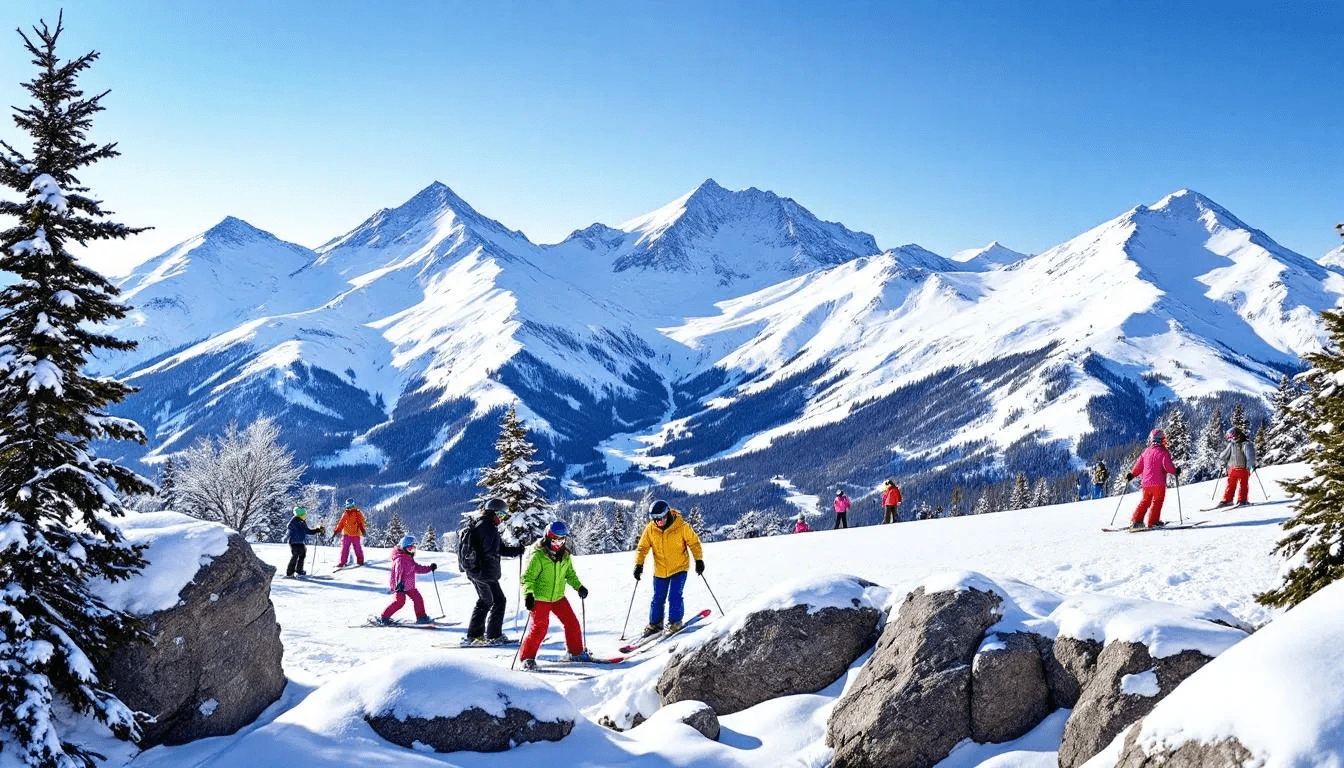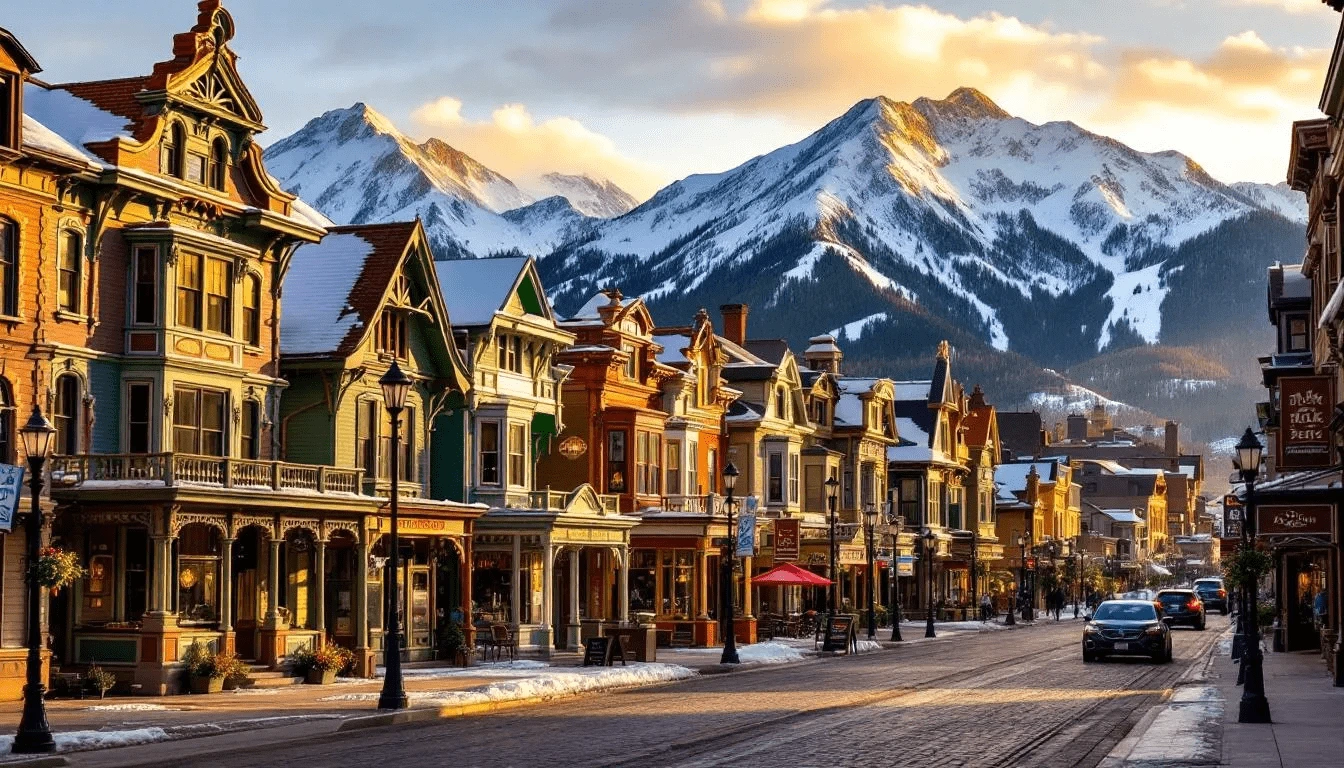Why Choose Breckenridge for Skiing
Breckenridge stands as one of the best ski resorts in North America, combining world-class skiing with authentic mountain town charm. This historic Colorado destination transforms the skiing experience across 2,908 skiable acres spanning five distinct peaks, each offering unique terrain for every skill level from first-time skiers to seasoned experts.

The resort’s base elevation of 9,600 feet ensures excellent snow conditions throughout an extended season that typically runs from November through May. Unlike other ski resorts that focus solely on the mountain experience, Breckenridge seamlessly integrates skiing with the vibrant culture of downtown Breckenridge, where historic Main Street offers world-class dining, shopping, and nightlife just steps from the slopes.
What sets Breckenridge apart is its family-friendly atmosphere combined with terrain that challenges even advanced skiers. The resort’s thoughtful layout and the convenient BreckConnect Gondola system make it easily accessible whether you’re staying slopeside or in the heart of this charming mountain town.
The Five Peaks: Your Complete Terrain Guide
Breckenridge’s unique five peaks system (Peaks 6, 7, 8, 9, and 10) creates distinct skiing experiences within one resort. Each peak offers different terrain characteristics, crowd levels, and accessibility options, allowing skiers to customize their experience based on skill level and preferences.
Peak 6: Above-Treeline Adventure
Peak 6 delivers the most challenging terrain at Breckenridge, featuring expert hike-to chutes and demanding black diamond runs that test even advanced skiers. The peak’s above-treeline location provides intermediate above-treeline bowls with breathtaking views of the Colorado mountains, but weather conditions can change rapidly at this elevation.
The terrain here requires careful consideration of snow conditions and weather patterns. On clear days, Peak 6 offers some of the most spectacular skiing in Summit County, but high winds and poor visibility can make these slopes dangerous. Expert skiers seeking untouched powder and steep chutes will find Peak 6 irresistible, while intermediate skiers should stick to the marked bowl skiing during stable conditions.
Peak 7: Intermediate Paradise
Peak 7 serves as intermediate paradise with wide cruiser runs perfect for building confidence and enjoying long, sweeping turns. The Independence SuperChair provides access to consistent blue runs including Claimjumper, Pioneer, Angel’s Rest, and Wirepatch—all offering excellent intermediate terrain without the crowds found on Peaks 8 and 9.
The gondola access via the BreckConnect system makes Peak 7 conveniently located for those staying downtown. These slopes typically offer better snow conditions later in the season due to their northeastern exposure, making Peak 7 an excellent choice for spring skiing when other peaks may become slushy earlier in the day.
Peak 8: The Iconic Experience
Peak 8 represents the heart of Breckenridge, home to the famous Horseshoe Bowl and the Imperial Express SuperChair—the highest chairlift in North America at 12,840 feet above sea level. This peak perfectly balances beginner-friendly green runs with advanced black terrain, plus houses the resort’s renowned terrain parks and competition venues.
The wide, longer green runs on Peak 8 provide ideal terrain for building confidence, while the upper mountain offers some of the most challenging inbounds skiing available. The peak’s connection to downtown via the BreckConnect Gondola makes it the most accessible option for day visitors, though this convenience can lead to longer lift lines during peak periods.
Peak 9: Beginner Central
Peak 9 serves as the ideal starting point for beginner skiers and families new to the sport. The Beaver Run base area and Quicksilver Chair provide gentle terrain perfect for first-time experiences, with a logical progression from green to blue runs as skills develop.
The recommended beginner progression starts with the Quicksilver Chair to access Silverthorne, then advances to Red Rover and the A-Chair as confidence builds. Despite its reputation for beginner terrain, Peak 9 also offers expert tree skiing options for advanced riders seeking variety, making it a peak that truly serves all skill levels.
Peak 10: Hidden Gem
Peak 10 remains Breckenridge’s best-kept secret, accessed via the Falcon SuperChair and offering varied terrain without the crowds. The signature Cimmaron run provides manageable moguls perfect for skill building, while Crystal black run offers an approachable introduction to advanced terrain for strong intermediate skiers.
This peak’s less crowded slopes provide quality intermediate terrain and serve as an excellent alternative when other peaks experience heavy traffic. The diverse terrain allows for progression from comfortable blue runs to more challenging black diamonds within the same area.
Skiing by Skill Level
Breckenridge’s carefully designed terrain progression accommodates skiers at every ability level, from those taking their first turns to experts seeking extreme challenges. The resort’s layout facilitates natural skill progression while providing options for every family member to enjoy their preferred level of skiing.
Beginner Skiing at Breckenridge
New skiers should start their Breckenridge experience at Beaver Run on Peak 9, where the Quicksilver Chair accesses the gentlest terrain. The recommended progression route begins with Silverthorne, advances to Red Rover, then graduates to the A-Chair as confidence develops. These wide green runs provide ample space for learning without intimidation from steeper terrain or faster skiers.
The resort’s wide green runs on Peaks 8 and 9 offer perfect confidence-building terrain, featuring gentle gradients and predictable snow conditions. Kid adventure zones add excitement with tunnels and decorations that make learning fun, while family-friendly facilities ensure easy mountain navigation. Professional ski school programs provide structured learning with certified instructors who understand how to progress beginners safely and efficiently.
Intermediate Blue Run Paradise
Intermediate skiers will find over 30% of Breckenridge’s terrain rated as blue runs, offering varied difficulty levels within this classification. Top blue runs include Claimjumper on Peak 7, Monte Cristo connecting multiple peaks, Wirepatch for wide cruising, and Pioneer for consistent intermediate skiing.
Peak-to-peak skiing routes allow intermediate skiers to experience the full mountain, while runs like Upper Lehman, Bonanza, and Lincoln Meadows provide mellow cruising when legs get tired. Snow conditions significantly affect blue run difficulty—morning groomed runs ski much easier than afternoon conditions with developing moguls or ice patches.
Advanced and Expert Terrain
Advanced and expert terrain at Breckenridge extends far beyond traditional black diamond classifications. Accessible black runs like Crystal, Duke’s Run, Northstar, and Peerless provide excellent introductions to advanced skiing without extreme consequences for mistakes.
Peak 6 offers expert terrain with hike-to chutes that challenge even seasoned experts, while tree skiing options across multiple peaks provide varied challenges based on snow conditions. The Imperial Express SuperChair opens high-alpine experience above treeline, where weather and snow conditions change rapidly. Competition-level terrain parks on Peak 8 offer features ranging from beginner boxes to professional-level jumps and rails.
Lift Tickets and Epic Pass Options
Understanding Breckenridge’s pricing structure helps maximize value for your skiing investment. Day lift tickets range from $219-$255 for advance purchases, with significantly higher prices for walk-up window purchases. The Epic Pass system provides exceptional value for anyone planning four or more ski days per season, not just at Breckenridge but across the entire Vail Resorts network.
Early season pass purchases offer maximum savings, with prices increasing as the season approaches. Military personnel receive discounts available in-person with valid identification, while advance purchase benefits include up to 20% savings for bookings seven or more days ahead, plus the convenience of skipping ticket lines.
Epic Day Pass options serve those with limited skiing plans, offering flexibility without full season commitment. The pass system’s integration with other Vail Resorts properties including Beaver Creek and Park City creates exceptional value for destination skiers planning multi-resort trips.
Equipment Rentals and Ski School
Equipment rental options include on-mountain locations for convenience or in-town shops for potentially better pricing and selection. Full gear packages typically include ski and winter gear such as skis or snowboard, boots, poles, bindings, helmets, and goggles, covering everything needed for a complete skiing experience.
Epic Pass holders receive an additional 20% discount off rental prices, while online booking can save up to 20% compared to walk-in rates. The rental quality at Breckenridge Resort meets high standards with regularly maintained, modern equipment suitable for all skill levels.
Once your trip wraps up, it'll be time to store your gear, which can be quite the hassle; but that’s where we come in. With secure, climate-controlled storage and convenient pickup and delivery, Rocket Closet makes it easy to keep your skis, boots, and outerwear organized and ready for your next adventure. Whether you’re a local or a seasonal visitor, you can skip the packing and baggage claim stress and let Rocket Closet handle the heavy lifting. Learn more about our storage options to keep your gear safe and ready to meet you at your next ski destination!
Professional ski school programs serve all ages and skill levels, from toddler programs through adult advanced technique clinics. Private lessons provide personalized instruction and faster progression, while group lessons offer social learning at lower costs. Lesson pricing typically equals single-day lift ticket costs, making professional instruction a valuable investment for skill development and safety.
Getting to and Around Breckenridge
Transportation from Denver International Airport utilizes shuttle services including Epic Mountain Express and other operators providing direct resort access. The drive takes approximately 90 minutes under normal conditions, though winter weather can extend travel times significantly.
Parking options include paid lots near the gondola at $10 per day for maximum convenience, or free satellite parking with shuttle service for budget-conscious visitors. The free BreckConnect Gondola system features three stops connecting downtown to the mountain base, eliminating driving concerns during ski days.
Breckenridge’s free public bus system operates throughout town with 10-minute frequency during peak hours, connecting lodging areas, Main Street, and lift access points. Walking distances remain manageable with Peak 8 base to Main Street requiring only 10 minutes, making car-free visits entirely feasible.
If you’re traveling without a car, Rocket Closet can make logistics even easier—storing your ski gear between trips or delivering it straight to your lodging before you arrive. No need to haul bulky bags through shuttles or airports—just show up ready to hit the slopes.
Best Times to Ski Breckenridge
Breckenridge’s ski season runs from November through May, with peak conditions from January to March when snowfall is heaviest and temperatures stay cold. Thanks to its 9,600-foot base elevation, the resort maintains excellent snow quality even late into spring, often extending operations through Memorial Day weekend.
Crowds are busiest on weekends, holidays, and during spring break. For fewer lift lines and a more relaxed experience, plan your trip for weekdays in January or February, early December before the holidays, or late April when the slopes quiet down.

